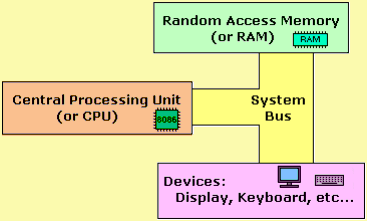This article will talk about the Assembly language programming 8086 Microprocessor. The 8086 instruction set plays a significant role in contemporary computing and offers robust software development assistance. Programmers can benefit from its vast range of instructions and compatibility with earlier systems. The concepts introduced by the 8086 remain constant as technology advances, demonstrating its importance in the computing industry.
Assembly Language Programming 8086 Microprocessor
Low-level embedded system design relies heavily on assembly-level programming to access CPU instructions for hardware manipulation. Compared to high-level programming languages, this most basic machine-level language is designed to create efficient code that uses fewer clock cycles and memory. It is a full-featured programming language that requires knowledge of embedded hardware to build programs. The fundamentals of 8086 assembly-level programming are covered here.
Assembly Level Programming 8086
All peripheral devices, including serial buses, RAM, ROM, I/O devices, and so forth, are represented by the 8086 processor and are externally connected to the CPU via a system bus. The CISC-based 8086 microprocessor is equipped with peripherals such as 32 I/O, serial connection, memory, and counters/timers. A program is necessary for the microprocessor to carry out tasks that need memory in order to read and save them.
The memory registers serve as the foundation for the 8086’s assembly-level programming. The primary component of microprocessors and controllers that are housed in memory and offer a quicker method of gathering and storing data is a register. Multiplication, addition, and other operations cannot be performed directly in memory; instead, registers are required to process and store the data if we wish to manipulate it for a processor or controller. Several types of registers that can be categorised based on their instructions are included in the 8086 microprocessor, including
- Eight general purpose registers make up the 8086 CPU. As seen in the diagram, each register has a unique designation, such as AXE, BX, CX, DX, SI, DI, BP, and SP. All of these are 16-bit registers, with four registers—AX, BX, CX, and DX—split into two sections, which are primarily used to store numbers.
- Segment registers: CS, DS, ES, and SS are the four segment registers that the 8086 CPU has. These registers are primarily used to store any data and to access a block of memory.
- Special purpose registers: There are two special function registers, including IP and flag registers, in the 8086 CPU. The IP register always tries to connect with the CS segment register and points to the instruction that is now running. Flag registers’ primary purpose is to alter CPU processes once mechanical tasks are finished and direct access is not possible.
Fundamental framework of an 8086 assembly program
Typical portions of an 8086 assembly program include:
- Data Segment: Specifies constants and variables.
- The code segment contains the instructions that need to be followed.
- Stack Segment: Manages function calls and temporary data (optional).
Salient characteristics of the 8086 microprocessor
The 8086 microprocessor’s salient characteristics are:
- 16-bit processor: Capable of processing 16-bit data simultaneously.
- Registers: Contains segment registers (CS, DS), general-purpose registers (AXE, BX), and special-purpose registers (IP, FLAGS).
- Code, Data, Stack, and Extra are the segments of memory that are separated via memory segmentation.
Tools for Executing Assembly Code in 8086
- EMU8086: A well-liked emulator for testing assembly code on 8086 microprocessors.
- DOSBox: A DOS emulator that enables the operation of 8086 programs.
- Assemblers for authoring and compiling 8086 assembly code are called TASM/MASM.
The 8086 Instruction Set: What is it?
The Intel 8086 microprocessor uses a collection of commands known as the 8086 instruction set to carry out tasks. It contains a range of instructions that let programmers make software for a wide range of applications, from basic maths to more intricate processing. Anyone wishing to work with the 8086 microprocessor and its applications must comprehend this set of instructions.
Grouping of Instruction Sets
Data Movement Operation
| Instructions | Definition/Meaning |
|---|---|
| MOV | Transfer data from source to destination. |
| XCHG | Swap the contents of two registers or a register and a memory location. |
| PUSH | Push data onto the stack. |
| POP | Pop the data from the stack. |
| LEA | Load Effective Address |
Arithmetic Operation Instruction
| Instructions | Definition/Meaning |
|---|---|
| ADD, SUB, ADC, SBB | Sum, difference, sum with carry, difference with borrow. |
| INC, DEC | Increment, decrement. |
| MUL, IMUL, DIV, IDIV | Multiplication and division (unsigned and signed). |
Logical Instruction
| Instructions | Definition/Meaning |
|---|---|
| AND, OR, XOR, NOT | Bitwise logical operations. |
| TEST | Bitwise AND operation modifies flags while operands remain unchanged. |
| SHL, SHR, SAL, SAR | Shift left, shift right (logical and arithmetic). |
| ROL, ROR, RCL, RCR | Left rotate, right rotate (with carry). |
Useful Examples of 8086 Assembly Code
First example: Print the code for “Hello, World!”
.model small
.stack 100h
.data
msg db ‘Hello, World!$’, 0
.code
main proc
mov ax, @data ; Data segment to be initialize
mov ds, ax
lea dx, msg ; message Load address definition
mov ah, 9 ; Function defined to display string
int 21h ; Call DOS interrupt
mov ax, 4c00h ; Exit program
int 21h
main endp
end main
Explanation of the Above Code
- The string “Hello, World!” is defined by msg db.
- mov ah, 9: Chooses to print a string using the DOS interrupt function.
- The function is executed by int 21h.
Logic and Arithmetic Instructions
The addition, division, and increment operations are the three categories into which the 8086 arithmetic and logic unit processes have been divided. The processor status register is impacted by the majority of arithmetic and logic instructions.
MOV, MUL, JMP, and other op-code are examples of assembly language programming 8086 mnemonics that are used to carry out operations. Examples of 8086 assembly language programming.
Addition
ORG0000h MOV DX, #07H // Transfer the number 7 to register AXE. // MOV AX, #09H // Transfer 9 to accumulator AXE. // Add AX, 00H // record the outcome in AXE after adding the CX value to the R0 value. // END
Multiplication
ORG0000h MOV DX, #04H // Transfer the number 4 to the register DX// MOV AX, #08H // Transfer the value 8 to accumulator AX// MUL AX, 06H // The Accumulator AXE stores the multiplied result. // END
Subtraction
ORG 0000h MOV DX, #02H // Transfer the value 2 to register DX// MOV AX, #08H // Transfer the value 8 to accumulator AX// SUBB AX, 09H // Result value is stored in the Accumulator A X// END
Division
ORG 0000h MOV DX, #08H // Transfer the value 3 to register DX// MOV AX, #19H // Transfer the value 5 to accumulator AX// DIV AX, 08H // final value is stored in the Accumulator AX // END
Thus, this covers Assembly Level Programming 8086, Arithmetic and Logic Instructions, and 8086 Processor Architecture with basic example programs.
Conclusion on Assembly Language Programming 8086
Programming the 8086 assembly gives you a practical grasp of how low-level processors carry out commands. This guide’s examples include fundamental tasks including looping, arithmetic, and text printing. You may develop a solid foundation in assembly language programming and learn about hardware interactions by working through these examples.

